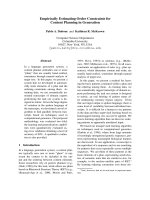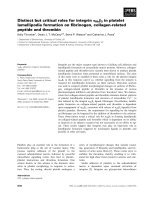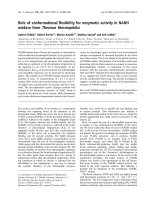Báo cáo "Sensory Properties and Consumer''''s Preference for Fondue Cheeses in Hanoi''''s Market " pdf
Bạn đang xem bản rút gọn của tài liệu. Xem và tải ngay bản đầy đủ của tài liệu tại đây (291.19 KB, 7 trang )
6
TP CHÍ KHOA HC VÀ CÔNG NGH Tp 43, s 2, 2005 Tr. 6-
12
SENSORY PROPERTIES AND CONSUMER’S PREFERENCE
FOR FONDUE CHEESES IN HANOI’S MARKET
CUNG THI TO QUYNH, HA DUYEN TU
I. INTRODUCTION
The word “cheese” is commonly used as a collective term for widely variable products
such as matured and non-matured cheese made with rennet, acid curd cheese, fresh cheese, and
even processed cheese. Fondue cheese is made by grinding and blending cheese, adding
“emulsifying salts”, heating while stirring to the proper temperature, stirring the melted mass for
several minutes at that temperature, putting it into suitable containers, and cooling. Additionally,
water, butterfat, whey powder, and/or caseinate are often added. The flavor of fondue cheese
distinctly differs from that of cheese, partly due to the heat treatment, partly to the melting
materials (P.Walstra, 1999).
In Vietnamese markets, the quantity and the variety of cheese are quite abundant. There are
about 170 types of cheese sold in supermarkets and restaurants in Vietnam (Vu Te Xien, 2004).
The quantity of cheese imported to Vietnam was 1,300 tons in 2003 and to Hanoi was about 365
tons with 125 types in the same year. Thirty percent of these cheeses was fondue cheese (mainly
La vache qui rit – cheese made in France) and it makes up an essential part of the cheese market.
Despite the fact that there are many types of cheese sold in Vietnamese markets, the
application of sensory evaluation is limited in grading some food products. This kind of sensory
practice is based on expert opinion. However, the quality of food products is a complex issue,
not to be defined by experts who search for the default of products or for subtleties that are of
little interest to the consumer. Furthermore, sensory profiling is a powerful tool to aid in quality
assurance and is essential for new product development (Bride R. Mc., 2001). Advances in
methodology and the development of integrated experimental design and analysis offer a
practical tool for specific use in profiling the sensory character of cheese. Thus, this study was
aimed at evaluating sensory properties, and consumer preference for some cheeses sold in
Hanoi’s market, and helping cheese manufacturers to understand, control and optimize the
sensory characteristics of cheese products.
II. MATERIALS AND METHODS
1. Subjects
Two groups of subjects participated in this study. The first group consisted of 8 students
(5 males and 3 females ranging in age from 21 to 23 years old) from the Institute of Biological
and Food Technology, Hanoi University of Technology. The panelists were enrolled in a
training program from October, 1
st
2005 to November, 15
th
2005 (average 70h/panelist) to detect
and identify sensory properties of Fondue cheeses and to evaluate the intensity of sensory
characteristics of these cheese on a 10-point universal intensity scale. The second group
consisted of 120 untrained subjects (55 males and 65 females, ranging in age from 18 to 65 years
old). They were selected from staff and students at universities in Hanoi, according to the
following criteria: they like fondue cheese.
7
2. Fondue cheeses
The cheeses used in 2 experiments were selected from Hanoi cheese markets. There were 6
kinds from French (included Bridel, Kiri, La vache qui rit, Party cubes, Picon and President) and
one from Vietnam (“Bo deo no” – made in Vinamilk company). All of cheeses were preserved
at 4 - 6°C before tasting. The maximum time of preservation (at the same temperature) recorded
in the packaging is 6 months. The cheese samples were served for each assessor for tasting at 1 x
1 x 1 cm sized in covered glass containers at 20°C
3. Methods
Descriptive analysis
This test aimed at pointing out the essential vocabulary needed for cheese product
description, sensorial characteristics of each type of cheese and the relation between cheese
samples and their attributes (Mc Bride R., Muir D., 2001).
All cheeses were evaluated by a panel using descriptive sensory profiling as described in
ISO 6564:1985. The sensory panel consisted of 8 panelists selected and trained according to
guidelines in ISO 8586-1:1993 and the laboratory was designed according to guidelines in ISO
8589:1988. Three replicates were performed for each cheese variety. The samples were served in
a randomized order and replicated with respect to each assessor. The assessors were asked to
evaluate the cheese attributes on a non-structural linear scale and to rinse out their mouth with
water and eat cucumber between samples. The tasting duration of each type of cheese was about
20 minutes and the break time was 5 minutes. The total duration of a session was 2,5h. The
average responses over replicates and assessors were used in the multivariate analyses (PCA,
PLSR).
Consumer test
A total of 120 regular cheese consumers, who were “naive” in that they had no training in
sensory evaluation, expressed their preference for each of the seven fondue cheeses studied. The
cheeses were evaluated for overall degree of preference of these cheeses on a 9-point hedonic
scale anchored with “Like extremely” and “Dislike extremely” at either end. The cheeses were
prepared at the standard described above. Spring water and cucumber were supplied for
cleansing palates between samples. All the panels performed the tests in the sensory laboratory.
No more information concerning the products or the experiment was given. All participants had
answered a questionnaire about their age and gender. Additionally consumption data were also
collected on all respondents.
4. Statistical analysis
The results were analyzed by Analysis of variance – ANOVA - (using SAS 8.1 for
Windows) in order to determine whether originality of cheeses had significant effects on cheese
profile and cheese preference. The ANOVA model was S
8
*A
3
*B
7
*C
25
(S: subject factor; A:
replication factor; B: product factor; C: attribute factor). The t-student had been used to
determine the difference of one attribute among the studied products. The means of the intensity
of each attribute and each type of cheese were gathered a matrix T (m, n), where m is the
number of product (m = 7) and n is the number of attribute (n = 25), was analyzed by Principal
Components Analysis (PCA) and Hierachical Classification Analysis (HCA) in order to specify
the correlation among sensory properties and the correlation among these products. The Partial
Least Squares Regression (PLS) had been used to figure out the relation between the descriptive
data and the preference scores of consumers. All analyses were performed by SAS
®
version 8.1
and SPAD
®
version 4.5.
8
III. RESULTS
1. Profile of Fondue cheeses
a. Sensory vocabulary
The 38 sensory terms (sensory attributes) were collected from various materials and from
the panels. After reductions, the remaining list of sensory attributes contained 25 terms. These
terms were divided in 5 categories as follows: Appearance (Color, brightness, flexibility), Odor
(Cream, milk, cooked, rancid, butter, lactic, overall odor intensity), Taste (sweetness, sourness,
bitterness, saltiness), Mouth-feel (Firmness, solubility, fineness, stickiness, elastic, variety of
aroma, fatness), Aftertaste (sweet, sour, bitter, salty).
b. Profile of fondue chesses
The profile of 7 studied cheeses is expressed in Figure 1. The ANOVA results showed a
significant difference among the 7 cheeses (F
6,144
= 3.41; p < 0.01). The results also indicated a
stability of the panels through 3 replicates (p < 0.001).
Among the 7 cheeses studied, the overall odor intensity of Bridel was highest, Kiri was
characterized by strong lactic and milk odor. La vache qui rit and Picon were the most salty and
finest texture. The intensity of firmness, butter odor and sweetness of Party cubes was highest.
President was characterized by fatness and “Bo deo no” by stickiness.
Figure 1. Conventional Profile scores of 7 fondue cheeses
A map of the Attributes of the 7 cheeses on the first plan of PCA (variance explained 62%)
was expressed in Figure 2. The results showed that sensory properties of the 7 cheeses were
classified into 4 opposite groups: Group 1 (milk odor, lactic odor), Group 2 (sourness, sour
aftertaste, solubility), Group 3 (firmness, stickiness and flexibility), and Group 4 (included the
remaining attributes, mainly odor attributes). There were close correlations among sensory
attributes, for example milk odor and lactic odor; brightness, cream odor, butter odor and variety
of aromas.
HCA analysis indicated that the 7 cheeses were principally classified into 4 groups (Figure
3). The numbers in Fig. 3 are expressed accumulated variances of classification of all products.
The higher the number, the more significant the classification. The fist group was Kiri (coded 2),
the second group contained Picon, Party cubes, La vache qui rit (coded 5, 4, 3), the third group
was “Bo deo no” (coded 7); and the last group was President and Bridel (coded 6, 1).
0
2
4
6
8
1
0
Color
Brightness
Flexibility
Cream odor
Milk odor
Cooked odor
Rancid odor
Butter odor
Lactic odor
Overall odor intensity
S
weetness
Sourness
BitternessSaltiness
Firmness
E
lastic
Solubility
Fineness
Stickiness
Variety of aroma
Fattiness
Sweet aftertaste
Salty aftertaste
Sour aftertaste
Bitter aftertaste
Bridel
K
iri
L
VQR
Party cubes
Picon
P
resident
B
o deo no
9
Figure 2. PCA-attribute map dimensions 1 and 2
Figure 3. Cluster analysis of 7 fondue cheeses
Characteristic properties of each group of cheese are indicated in Figure 4. The
characteristic property of Bridel was a sweet aftertaste and stickiness ; Kiri was milk odor and
lactic odor; La vache qui rit and Picon were fineness, elasticity, color, saltiness, salty aftertaste;
Party cubes was butter odor, sweetness, cream odor, brightness and rancid odor; President was
fatness, firmness, stickiness; and “Bo deo no” was stickiness, flexibility.
Figure 4. PCA biplot of sensory properties and
cheese products
Figure 5. Overall degree of preference of 2 groups
2. Consumer preference
The Pearson correlations, among preference attributes, showed significant correlations (P <
0.01) between the overall degree of preference. Average preference of most cheeses was
preferred at an above average level (from 5.70 to 6.51 points), and “Bo deo no” - cheese made in
Vietnam - was preferred to La vache qui rit and graded at the same level with 3 types of cheese
made in France.
C
lassification hierarchique directe
1
6
7
3
4
5
2
1.22
2.06
2.48
4.11
5
.26
9.88
0
1
2
3
4
5
6
7
8
Bridel
Kiri
LVQR
Party
cubes
Picon
President
Bo deo
no
Product
Preference score
Group 1 Group 2
10
Analysis clustering (HCA) and the result of the t-student analysis showed that the
customers were principally classified into 2 groups with characters as follows:
- Group 1: 48.31% males and 51.69% females; young people (< 25 ages) were 49.44%; the
frequency of using cheese was high
- Group 2: 32.26% males and 67.74% females; young people (< 25 ages) were 67.74%; the
frequency of using cheese was lower than group 1.
The overall degree of preference of the 7 cheeses of 2 consumer groups was performed in
Figure 5. The overall degree of preference of group 1 (> 6 points) was higher than degree of
group 2 (< 6 points). These results suggested that the cheese preference might be proportioned to
the frequency of cheese consumption. Besides, “Bo deo no” - cheese made in Vietnam - was
rated quite highly by both groups at an above average level (5.8 points). This reflects that this
product is suitable for Vietnamese consumers, irrespective of age or gender. This is good news
for Vietnamese cheese producers.
PLS regression by overall degree of preference scores on data matrix showed that a linear
model could explain the overall degree of preference from the answers of the study groups (120
people). The result was that the characteristics contributed positively to the preference of
consumers in 2 groups were lactic odor, butter odor, and firmness. The attributes which reduced
the consumer preference included bitterness and bitter aftertaste.
Furthermore, the results also indicated that butter odor, lactic odor, the variety of aromas,
firmness and fatness correlated positively to the preference of the consumer in Group 1. Color,
brightness, bitterness, elasticity, salty aftertaste and bitter aftertaste were negative attributes for
this consumer group.
Figure 6. PLS regression of the descriptive profiling data and the preference scores for consumers
For group 2, the positive attributes were flexibility, butter odor, lactic odor, firmness and
stickiness. Otherwise, milk odor, overall odor intensity, bitterness and bitter aftertaste
diminished the individual’s preference.
This result initiated a new approach to the ideal model of fondue cheese, for further
research concerned with quality and the processing of cheese.
Color
Brightness
Butter odor
Variety of aroma
Firmness
A-saltiness
A-bitterness
Elastic
Bitterness
Lactic odor
F
atty
-0.3
-0.2
-0.1
0
0.1
0.2
0.3
0.4
0.5
0.6
Group 1 Group 2
Flexibility
Milk
odor
Overall odor
Stickines
11
IV. CONCLUSION
In the summary, the study showed that 25 attributes are an essential part of the fondue
cheese descriptions. Seven studied cheeses were classified in 4 groups with their corresponding
characters: Group 1 (Kiri), Group 2 (Bridel and President), Group 3 (La vache qui rit, Party
cubes, Picon) and Group 4 (Bo deo no).
The overall degree of preference of 7 cheeses was rather clear, at an above average level (>
5.7/9 points) and was graded according to degree of preference as follows: Party cubes,
President, Kiri, Picon, Bo deo no, Bridel and La vache qui rit. The “Bo deo no” - cheese made
in Vietnam – was highly rated at 5.86 points. The regression analysis indicated that the most
preferred attributes of the 7 above cheeses were lactic odor, butter odor, and firmness.
Vietnamese consumers disliked bitterness, and a bitter aftertaste in all studied products.
The results of this study initiated the new approach to the ideal model of fondue cheese for
the other researches concerned with quality and the processing of cheese.
Acknowledgment. Special thanks for Nguyen Thi Lan Anh, Nguyen Thi Minh Tu, Nguyen Ba
Thanh and Cung To Nga for their precious help in consumer tests and thanks to all assessors
for their participation.
REFFERENCES
1. International Standard, ISO 6564:1985 - Sensory analysis – Methodology – Flavour
profile methods.
2. International Standard, ISO 8586-1:1993 - Sensory analysis – General guidance for the
selection, training and monitoring of assessors.
3. International Standard, ISO 8589:1998 - Sensory analysis – General guidance for the
design of test rooms.
4. B. A. Law - Technology of cheese making, CRC Press, Sheffield, England, 2002.
5. R. Mc Bride, D. D. Muir - The grading and sensory profiling of cheese, CRC Press,
Sheffield, England, 2001.
6. J. M. Murray, C.M. Delahunty, and I. A. Baster - Descriptive sensory analysis: past,
present and future, Food research International 34 (2001) 461-471.
7. H.D. Nguyen, Ha D.T., and D. Luu - The role of sensory evaluation in food quality
management and development, Proceedings of the 8
th
Asian Food Conference, Hanoi,
2003, 862-866.
8. C. Salles, S. Dalmas, and C. Septier - Production of a cheese model for sensory
evaluation of flavor compounds, Le Lait 75 (6) (1995).
9. P. Walstra, T. J. Geurts, A. Noomen, A. Jellema, and Van Boekel - M. A. J. S., Dairy
Technology: Principles of Milk, Properties and Processes, USA, 1999, 539-708.
10. T. X. Vu - The habit of using cheese of customers in Ha Noi and Ho Chi Minh City,
Industrial Journal 22 (2004) 37-39.
SUMMARY
The objective of this study was to analyze the sensory properties and to assess the
preference of consumer in Hanoi for 7 types of fondue cheese (Bridel, Kiri, La vache qui rit,
12
Party cubes, Picon, President and “Bo deo no”). Two tests have been carried out: the descriptive
test and the preference test. In the former, a trained panel of 8 members indicated that there were
25 profiled attributes of fondue cheese which have been used with high frequency and described
exactly sensory quality of these types of cheese. The results of univariate and multivariate data
analyses showed a significant difference among the cheese samples, and the 7 evaluated types of
cheese could be separated into 3 groups with their characterized properties. In the preference
test, a consumer panel of 120 assessors assessed the consumer preference of these 7 types of
cheese on a 9-point scale (1-extremly dislike, 9-extremly like). The result was that these 7 types
of cheese were preferred at an above average level. Hierarchical Classification Analysis (HCA)
indicated that there were 2 consumer groups with different preferences and the overall
preference of the consumer depended on the frequency of product use. Partial Least Squares
Regression Analysis (PLS) showed the correlation between sensory properties and the consumer
preference for a class of fondue cheese. An ideal model of fondue cheese for Vietnamese
consumers had been initiated in order to aid in studies of consumer acceptability.
Key words: descriptive analysis, fondue cheeses, consumer preference
NGHIÊN C/U TÍNH CH1T C2M QUAN VÀ TH5 HI6U NG78I TIÊU DÙNG :;I V<I
PHO MÁT NÓNG CH2Y T@I TH5 TR78NG HÀ NAI
Nghiên cQu này tSp trung phân tích các tính chWt cX m quan và thY hiZu c[a ng\]i tiêu dùng
Hà N_i `ai vbi 7 loci pho mát nóng cháy (Bridel, Kiri, La vache qui rit, Party cubes, Picon,
President và Bò `eo nf). Hai phép thh cXm quan `ã `\jc thkc hiln là phép thh mô tX và phép
thh thY hiZu. Thông qua sk phân tích c[a h_i `nng gnm 8 thành viên `ã qua huWn luyln, chúng
tôi `ã tìm `\ jc 25 thu_c tính cXm quan c[a pho mát nóng chXy `\jc sh dqng vbi trn suWt cao
nhWt và mô tX chính xác tính chWt cXm quan c[a nhóm pho mát này. KZt quX phân tích sa lilu
`fn và `a biZn `ã chs ra rtng các muu pho mát khác nhau có nghva, và 7 muu này có thw `\ jc
phân chia thành 3 nhóm vbi các tính chWt cXm quan `xc tr\ng. Trong phép thh thY hiZu, chúng tôi
m]i 120 ng\]i thh, tham gia `ánh giá mQc `_ \a thích `ai vbi 7 sXn phym trên thang thY hiZu 9
`iwm (vbi 1 là ckc kì không thích và 9 là ckc kì thích). KZt quX phân tích cho thWy cX 7 sXn phym
`zu `\jc `ánh giá trên mQc `_ trung bình (5 `iwm). Phép phân tích phân nhóm theo thQ bSc
(HCA) chs ra rtng có 2 nhóm ng\]i tiêu dùng có mQc `_ \a thích khác nhau và mQc `_ \a thích
chung `ai vbi sXn phym c[a h{ phq thu_c vào trn suWt sh dqng sXn phym. KZt quX c[a phân tích
hni quy bán phrn nh| nhWt (PLS) chs ra mai t\fng quan gi}a tính chWt cXm quan và mQc `_ \a
thích c[a ng\]i tiêu dùng `ai vbi các sXn phym pho mát nóng chXy. Mô hình lí t\~ng c[a pho
mát nóng chXy c[a ng\]i tiêu dùng Vilt Nam `ã b\bc `r u `\jc hình thành, kZt quX này s• góp
phrn h€ trj nh}ng nghiên cQu vz mQc `_ chWp nhSn c[a ng\]i tiêu dùng `ai vbi sXn phym.
45a ch6: Nh8n bài ngày 12 tháng 4 n;m 2004
•ci h{c Bách khoa Hà N_i.









